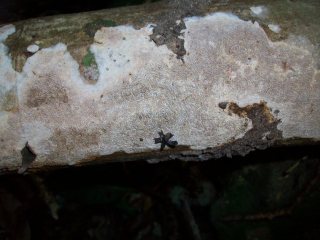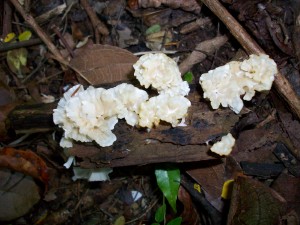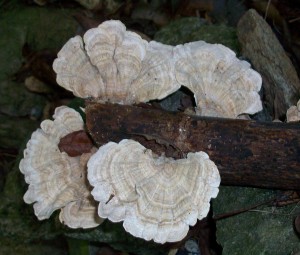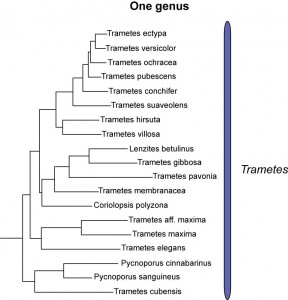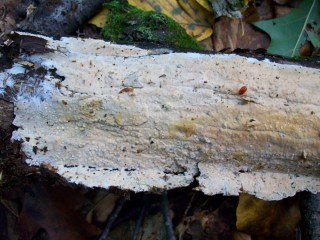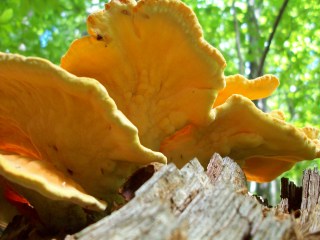Recent Polyporales news
Coriolopsis psila comb. nov. (Agaricomycetes) and two new Coriolopsis records for Brazil
Georgea S. Nogueira-Melo, Priscila S. de Medeiros, Allyne C. Gomes-Silva, Leif Ryvarden, Helen M.P. Sotão & Tatiana B. Gibertoni in Mycotaxon
Abstract — The new combination Coriolopsis psila is proposed and C. brunneoleuca and C. hostmannii are reported as new to Brazil. Descriptions of these collections and a key to the eight accepted Coriolopsis species reported from Brazil are provided
A new species of Inonotus (Hymenochaetaceae) and Trametes cingulata (Polyporaceae) newly recorded from Brazil
Maira Cortellini Abrahão & Adriana de Mello Gugliotta in Mycotaxon
Abstract — Two interesting species found during a survey of polypore fungi in northwestern São Paulo State, Southeast Brazil, are described and illustrated. Inonotus multisetifer is proposed as a new species characterized by resupinate basidiomata with round to angular pores, 6-9 per mm, acute setal hyphae embedded in trama, subulate hymenial setae, and globose to subglobose basidiospores. Trametes cingulata constitutes a first record from Brazil.
Taxonomy and phylogeny of the genus Megasporoporia and its related genera
Hai-Jiao Li & Baokai Cui in Mycologia
Abstract — Taxonomic and phylogenetic studies on Megasporoporia s.l. were carried out. Phylogenetic analysis based on ITS and nLSU sequences showed that Megasporoporia s.l. belonging to the core polyporoid clade, however, it is not monophyletic, and four clades were recognized. The Megasporoporia s.s. clade includes M. setulosa and two new species, M. bannaensis and M. minor spp. nov. Two monophyletic clades were segregated from Megasporoporia s.l., and two new genera were established. Megasporia gen. nov. is composed of M. cystidiolophora, M. ellipsoidea, M. hexagonoides, M. major, M. violacea, and two new species, M. guangdongensis and M. hengduanensis spp. nov. Megasporoporiella gen. nov. including M. cavernulosa, M. rhododendri, M. subcavernulosa, and two new species, M. lacerata and M. pseudocavernulosa spp. nov. Megasporoporia quercina grouped with Grammothele fuligo in the Grammothele clade, so it is transferred to Grammothele and a new combination, G. quercina is proposed. The main morphological characters of Megasporoporia and the two new genera are discussed, and identification keys to the three genera are provided
Antrodiella chinensis sp. nov., a Chinese representative of the Antrodiella americana complex
Hai-Sheng Yuan in Mycological Progress
Abstract — A new wood-decaying polypore, Antrodiella chinensis, is described and illustrated from China based on morphological characteristics and phylogenetic analysis of rDNA ITS sequences. The new species belongs to the Antrodiella americana complex, and is characterized by an annual habit, resupinate basidiocarps, cream to straw coloured pore surface with larger and regular pores, and oblong-ellipsoid basidiospores. Discriminating characteristics between the new species and the closely related species in the complex are discussed
Type studies of corticioid Hymenomycetes (Basidiomycota) with aculei – Part II
Karen K. Nakasone in Czech Mycology
Abstract — Type specimens of fifteen, resupinate, crustose basidiomycetes with aculei described by various authors were examined. Nine taxa are later synonyms: Hydnum albiceps Berk. & Rav. (= Phlebia fascicularis), Hydnum chrysodon Berk. & M.A. Curtis (= Hydnophlebia chrysorhiza), Hydnum hypochrum Berk. & Broome (= Dentipellis leptodon), Hydnum micheneri Berk. (= Steccherinum ciliolatum), Hydnum pallidum Cooke & Ellis (= Xylodon fimbriiformis), Hydnum schweinitzii Berk. & M.A. Curtis (= H. chrysorhiza), Irpex furfuraceovelutinus Rick (= Kneiffiella stereicola), Irpex galzinii Bres. (= Amyloporia sinuosa), and Merulius elliottii Massee (= H. chrysorhiza). Irpex fimbriiformis Berk. & M.A. Curtis (≡ X. fimbriiformis) is accepted as a distinct species. Five new combinations are proposed: Cristinia decolorans for Irpex decolorans Cooke, Dentipellis ohiensis for Hydnum ohiense Berk., an earlier name for Dentipellis dissita (Berk. & Cooke) Maas Geest., Odonticium depauperatum for Irpex depauperatus Berk. & Broome, Peniophorella tessulata for Kneiffia tessulata Berk. & M.A. Curtis, an earlier name for Peniophorella rudis (Bres.) K.H. Larss., and Schizopora archeri for Irpex archeri Berk.
A new species of Laetiporus (Basidiomycota, Polyporales) from the Caribbean basin
Mark T. Banik, Daniel L. Lindner, Beatriz Ortiz-Santana & Deborah J. Lodge in Kurtziana
Abstract — Laetiporus caribensis is described as a new species, causing brown rot on hardwoods in the Caribbean basin. Laetiporus caribensis is distinguished from described species in the genus by smaller basidiospores. In addition, single spore isolates of L. caribensis are incompatible with those of the known species of Laetiporus from North America and Japan. The ITS sequence of L .caribensis is divergent from other members of the genus, being at least 50 base pairs different from L. gilbertsonii, the most closely related species.
The phylogenetic disposition of Postia s.l. (Polyporales, Basidiomycota) from Patagonia, Argentina
María Belén Pildain and Mario Rajchenberg in Mycologia
Abstract — We investigated the phylogenetic relationships of Postia species from Patagonia with rDNA ITS and LSU sequences, together with morphological, cultural and biological features. All species in the genus were included in a ‘Postia clade’ irrespective of whether their spores were thin or thick-walled. This clade is characterized by tetrapolar mating, a normal nuclear behavior, metachromatic generative hyphae and absence of fiber hyphae in culture. One subclade merged the austral taxa P. pelliculosa and P. punctata, but otherwise no distinct relationships were found regarding spore shape, spore wall thickness and geographical distribution of taxa. The austral P. venata and the endemic P. carbophila, with thin-walled basidiospores, occupied variable positions in both analyses. Postia caesia from Patagonia grouped within the P. caesia species complex but on a separate branch. In contrast, P. rennyi and P. balsamea from Patagonia corresponded well with strains from other geographic areas. The two austral species in Ryvardenia, R. cretacea and R. campyla, characterized by non-metachromatic hyphae, bipolarity and an astatocoenocytic nuclear behavior, formed an independent subclade among the dimitic genera of the ‘Antrodia clade’, far from other Postia taxa within which they had been placed previously, supporting their inclusion in a genus of their own. Postia carbophila merged with other Postia species and not with Postia (Rhodonia) placenta as suggested previously on the basis of morphological comparisons. Instead, the latter species grouped with taxa in the dimitic genus Amyloporia with which it shares a heterocytic nuclear behavior. A separation between specimens of Postia pelliculosa and Ryvardenia cretacea from either side of the Pacific, i.e. SE Australia/New Zealand and S Argentina/S Chile, suggests they could be considered different at the species level from a phylogenetic point of view
New species and distinctive geographical divergences of the genus Sparassis (Basidiomycota): evidence from morphological and molecular data
Qi Zhao, Bang Feng, Zhu L. Yang, Yu-Cheng Dai, Zheng Wang & B. Tolgor in Mycological Progress
Abstract — Species of the genus Sparassis in East Asia were investigated using morphology and DNA sequences data. Phylogenetic analyses inferred from sequences of the internal transcribed spacer (ITS), the nuclear gene coding for the ribosomal large subunit (nLSU) and partial gene coding RNA polymerase subunit II (rpb2) strongly supported lineages corresponding to morphological features. Three taxa, S.subalpina, S. cystidiosa f. flabelliformis and S. latifolia were recognized from East Asia, and the former two taxa are new to science. The occurrence of S. latifolia in Japan and in the Russian Far East was confirmed. Geographical divergences of Sparassis in the Holarctic were observed. Most species have relatively narrow distribution ranges, and taxa with intercontinental distributions were not detected. Divergence of species in the Northern Hemisphere in different clades appears to have taken place at different times: the S.latifolia-crispa-radicata species complex appears to haveundergone a recent radiation, while the S. subalpinabrevipes-spathularia species complex represents a relatively ancient speciation
The Paleozoic Origin of Enzymatic Lignin Decomposition Reconstructed from 31 Fungal Genomes
Dimitris Floudas et al in Science
Abstract — Wood is a major pool of organic carbon that is highly resistant to decay, owing largely to the presence of lignin. The only organisms capable of substantial lignin decay are white rot fungi in the Agaricomycetes, which also contains non–lignin-degrading brown rot and ectomycorrhizal species. Comparative analyses of 31 fungal genomes (12 generated for this study) suggest that lignin-degrading peroxidases expanded in the lineage leading to the ancestor of the Agaricomycetes, which is reconstructed as a white rot species, and then contracted in parallel lineages leading to brown rot and mycorrhizal species. Molecular clock analyses suggest that the origin of lignin degradation might have coincided with the sharp decrease in the rate of organic carbon burial around the end of the Carboniferous period.
You can read more about this project in the Hibbett Lab news site:
http://hibbettlablog.wordpress.com/2012/06/30/sap-paper-published-in-science/
Checklist of Iranian non-gilled/non-gasteroid hymenomycetes (Agaricomycotina)
Masoomeh Ghobad-Nejhad & Nills Hallenberg in Mycotaxon
Abstract — This list includes 395 species of Iranian non-gilled/non-gasteroid hymenomycetes. Corticioid, poroid (polypores), hydnoid, clavarioid, cantharelloid, thelephoroid, and cyphelloid fungi are covered, together with heterobasidiomycetes. Almost all the species are supported by at least one herbarium specimen. The list has been compiled mainly from material collected by the authors, verified reports and literature. Nineteen species are reported for the first time from the country, and 118 species are added to the most recent account of aphyllophoroid fungi of North Iran by Hallenberg (1981, Mycotaxon 12: 473–502). The occurrence in Iran of six species is regarded as doubtful, while 12 species are excluded. The number of species known for each province in Iran is listed, with Golestan shown to be the most species-rich province. The total number of species recognized for major Iranian phytogeographical territories is also noted and Funalia trogii, Inonotus hispidus, and Schizophyllum commune are shown to be the most widespread species. A permanent repository for continuous updates has been made available via the Myco-Lich website, and future new records for the country will be published online. Users can access the latest changes to the checklist via subscription to a feed (RSS). The link to the checklist is http://www.myco-lich.com/mycologyof- iran/basidiomycota/checklists/National-checklist.
Full checklist is available here
Notes on Perenniporia Murrill (Basidiomycota) from the Brazilian Amazonia
Priscila Sanjuan Medeiros, Allyne Christina Gomes-Silva, Helen Maria Pontes Sotão, Leif Ryvarden & Tatiana Baptista Gibertoni in Nova Hedwigia
Abstract — Perenniporia cremeopora, P. roseoisabellina and P. ellipsospora are reported as new to Brazil, while P. parvispora and P. tephropora for the Brazilian Amazonia. Description and figures of the new occurrences in Brazil and a key to the species ofPerenniporia registered for the Brazilian Amazonia are provided.
Peniophora aluticolor (Fungi, Basidiomycota), an orphaned species restudied
Ireneia Melo, José Cardoso, Margarita Dueñas, Isabel Salcedo & M. Teresa Telleria in Nova Hedwigia
Abstract — Type specimens of Peniophora aluticolor Bres. & Torrend, an orphaned species described from Madeira, have been examined and the combination Phanerochaete aluticolor (Bres. & Torrend) Melo, J. Cardoso, M. Dueñas, Salcedo & Telleria is proposed. It can be separated from the related and the Mediterranean-distributed Ph. martelliana by smaller spores and thick-walled cystidia and subicular hyphae
Interesting resupinate species of Rigidoporus from Brazil
Mauro C. Westphalen & Rosa Mara Borges da Silveira in Nova Hedwigia
Abstract — During a survey of polypores carried out in Southern Brazil, two rare resupinate species of Rigidoporus were found. Rigidoporus crocatus is registered for the first time from Brazil and is characterized by the absence of cystidia. Rigidoporus undatus, a neotropical species that lacks descriptions in recent works, is characterized by isabelline pore surface and globose basidiospores. In this work both species are fully described, illustrated and compared to other similar species. Besides, Poria nigrescens, previously considered a synonym of R. crocatus, is synonymized with R. vinctus through type studies.
Antrodia tropica sp. nov. from southern China inferred from morphological characters and molecular data
Bao-Kai Cui in Mycological Progress
Abstract — Antrodia tropica sp. nov. is described and illustrated on the basis of collections originating from Hainan, southern tropical China. Both the morphology and phylogenetic analysis of rDNA ITS sequences support this new species. Morphologically, it is characterized by resupinate basidiocarps, an annual growth habit, greyish to pinkish buff pore surface, a dimitic hyphal system with clamped generative hyphae, and cylindrical to subfusiform basidiospores. The hymenophoral trama is dominated by generative hyphae, whereas skeletal hyphae are dominant in the subiculum. Molecular phylogeny inferred from ITS sequence data suggested a close relationship between A. tropica and two other Antrodia species, including A. huangshanensis reported from China and A. ramentacea found mostly in boreal Eurasia
New species and phylogeny of Perenniporia based on morphological and molecular characters
Chang-Lin Zhao, Bao-Kai Cui & Yu-Cheng Dai in Fungal Diversity
Abstract — Three new resupinate, poroid, wood-inhabiting fungi, Perenniporia aridula, P. bannaensis and P. substraminea, are introduced on the basis of morphological and molecular characters. Molecular study based on sequence data from the ribosomal ITS and LSU regions supported the three new species’ positions in Perenniporia s.s., and all of them formed monophyletic lineages with strong support (100 % BP, 1.00 BPP). Phylogenetic analysis revealed seven clades for the 31 species of Perenniporia s.l. used in this study. Among them, Perenniporiella clustered with Perenniporia ochroleuca group, and then subsequently grouped with Abundisporus. In addition, the P. ochroleuca group, the P. vicina group, the P. martia group and P. subacida formed well supported monophyletic entities, which could be recognized as distinct genera, and they are not related to P. medulla-panis which belongs to Perenniporia s.s. clade. An identification key to 38 species of Perenniporia occurring in China is provided
A preliminary checklist of polypores of Peru, with notes on distribution in the Andes-Amazon region and new records for the country
Salvador-Montoya CA, Millán B, Janovec JP and Drechsler-Santos ER in Mycosphere
Abstract — A checklist of 33 polypore species (Hymenochaetales and Polyporales) from the Camanti-Marcapata Biological Corridor (CMBC) of Cusco, Peru, is provided with data about distribution in the Andes-Amazon region. More than 90% of polypore species reported herein are new records to the country
Contribution to the knowledge of polypores (Agaricomycetes) from the Atlantic forest and Caatinga, with new records from Brazil
Baltazar JM, Drechsler-Santos ER, Ryvarden L, Cavalcanti MAQ and Gibertoni TB in Mycosphere
Abstract — The Atlantic Forest is the better known Brazilian biome regarding polypore diversity. Nonetheless, species are still being added to its mycota and it is possible that the knowledge of its whole diversity is far from being achieved. On the other hand Caatinga is one of the lesser known. However, studies in this biome have been undertaken and the knowledge about it increasing. Based in recent surveys in Atlantic Forest and Caatinga remnants in the Brazilian States of Bahia, Pernambuco and Sergipe, and revision of herbaria, twenty polypore species previously unknown for these states were found. Fuscoporia chrysea and Inonotus pseudoglomeratus are new records to Brazil and nine are new to the Northeast Region. Furthermore, four species previously known from Brazil were found for the first time in the Atlantic Forest, viz. Flabellophora parva, F. chrysea, I. pseudoglomeratus and Trametes lactinea, and three in the Caatinga, viz. I. portoricensis, Phylloporia spathulata and Schizopora flavipora. Keys to the main taxa are provided.
Stipitate stereoid basidiocarps have evolved multiple times
Elisabet Sjökvist, Ellen Larsson, Ursula Eberhardt, Leif Ryvarden & Karl-Henrik Larsson in Mycologia
Abstract — Stipitate stereoid fungi are Basidiomycetes with a stipe, a spathulate- to funnel-shaped pileus, a smooth hymenophore, and hyaline, smooth spores. Representatives of the genera Cotylidia, Cymatoderma, Muscinupta, Podoscypha and Stereopsis were subjected to molecular phylogenetic analyses based on nuclear ribosomal large subunit, 5.8S and ITS sequences. For four of the genera the type species was included in analyses. Stereopsis radicans, the type species of Stereopsis, forms a lineage with the corticioid species Clavulicium globosum but could not be placed in any of the presently accepted orders within Agaricomycotina. Stereopsis vitellina falls within the Atheliales, making it the first pileus- and stipe-forming fungus recovered in this order. Cotylidia and Muscinupta again are shown to be members of the Hymenochaetales, whereas Cymatoderma and Podoscypha belong in the Polyporales. Cymatoderma is polyphyletic and Cymatoderma sensu stricto is separated from other stipitate stereoid fungi in the Polyporales, whereas the remaining Cymatoderma species are nested within a well supported clade holding all Podoscypha species but also Abortiporus biennis.
A new species of Hyphoderma (Meruliaceae, Polyporales) and its discrimination from closely related taxa
M. Teresa Telleria, Margarita Dueñas, Esperanza Beltrán-Tejera, J. Laura Rodríguez-Armas & María P. Martín in Mycologia
Abstract — Thirty-five corticioid collections from the Canary Islands and Azores Archipelago were examined morphologically and subjected to molecular phylogenetic analysis. These specimens, almost all collected on endemic and/or xerophilic vegetation, were similar in morphological and ecological characteristics to Hypochnicium prosopidis from the Sonoran Desert (Arizona, USA) and Hyphoderma amoenum. Thirty-seven new ITS nrDNA sequences from these specimens, including the nomenclatural type of the above-mentioned species, were obtained and aligned with homologous sequences from GenBank. These collections were distributed in two strongly supported monophyletic clades. However, similar patterns of morphological variability shared by specimens included in both clades and their differences with related species suggest that they should be described as a single new species. Therefore Hyphoderma macaronesicum is proposed. Studies will be required to test, in a more robust multilocus genealogical framework, whether these populations constitute two cryptic species or whether they are the same taxon. The position of Hypochnicium prosopidis in the resolved tree and its morphological characters suggest that it should be included in Hyphoderma and the new combination Hyphoderma prosopidis is proposed.
Antrodia hyalina, a new polypore from Russia, and A. leucaena, new to Europe
Viacheslav Spirin, Otto Miettinen, Jorma Pennanen, Heikki Kotiranta & Tuomo Niemelä in Mycological Progress
Abstract — A new polypore species, Antrodia hyalina, is described from Russia. It is morphologically similar to Antrodia pulvinascens, but differs in having annual, thinner and softer basidiocarps, solid skeletal hyphae, and cylindrical spores. Antrodia leucaena, originally described from China, is reported as new from Finland and Russia on Populus tremula. Antrodia wangii is regarded as a synonym of A. bondartsevae.
Four new polypore species from the western United States
Josef Vlasák, Josef Vlasák Jr. & Leif Ryvarden in Mycotaxon
Abstract — Four new species of polypores are described from California, Oregon, and Washington, U.S.A. Antrodia madronae, seemingly confined to dead stems and branches of Arbutus menziesii, is closely related to European Antrodia sandaliae growing on Arbutus unedo. The generic position is evaluated for Ceriporiopsis pseudoplacenta, a strikingly colored species with many unique features that seems surprisingly common in the northwestern states. Fuscoporia palomari is distinguished from the similar F. viticola by much larger pores and spores. Skeletocutis subodora differs from S. odora by having thick subiculum, differently shaped basidiospores, abundant cystidioles, and no skeletal hyphae in the context. The nrDNA ITS region of all new species gave unique sequences in GenBank.
Two new species of Hyphoderma (Agaricomycetes) from India
Priyanka & G.S. Dhingra in Mycotaxon
Abstract – Two new corticioid species, Hyphoderma bicystidiatum and H. subglobosum, are described from Kangra Hills in Himachal Pradesh.
Morphological and ITS rDNA-based phylogenetic identification of two new species in Tinctoporellus
Hai-Sheng Yuan & Xian-Zhen Wan in Mycological Progress
Abstract — Two new poroid wood-inhabiting basidiomycetes, Tinctoporellus bubalinus and T. hinnuleus, are described and illustrated based on morphological characteristics and phylogenetic analysis of rDNA ITS sequences. Tinctoporellus bubalinus is characterized by annual, resupinate basidiocarps, white to buff coloured pore surface and thin- to slightly thickwalled, richly branched and contorted dendrohyphidia. Tinctoporellus hinnuleus is characterized by annual, resupinate basidiocarps, cinnamon, clay-buff to fawn pore surface, thinwalled, richly branched and contorted brown dendrohyphidia. Discriminating characters between the new species and the closely related species are discussed. A key to accepted species in Tinctoporellus is provided
Neotypification of Amauroderma picipes Torrend, 1920 (Ganodermataceae, Agaricomycetes)
Gomes–Silva AC & Gibertoni TB in Mycosphere
Abstract — The holotype of Amauroderma picipes, described by Torrend in 1920 from material collected in the State of Bahia, Brazil, was recently located in herbarium URM, but it was in poor conditions. Due to the loss of the typical characteristics of the species, a neotype is designated here. The material chosen for A. picipes was collected in the State of Rio de Janeiro and deposited in herbarium SP (95472) as A. schomburgkii f. schomburgkii. A full modern description, pictures of the basidiomata and basidiospores in light microscopy and SEM are provided.
Radulomycetopsis (Agaricomycetes), a new corticioid genus from India
G.S. Dhingra, Priyanka & Jaspreet Kaur in Mycotaxon
Abstract — A new corticioid genus, Radulomycetopsis, is described for the new species, R. cystidiata, from West Kameng in Arunachal Pradesh.
A new species of Skeletocutis (Polyporaceae) on bamboo in tropical China
Li-Wei Zhou & Wen-Min Qin in Mycotaxon
Abstract — Skeletocutis bambusicola sp. nov. is described and illustrated from the tropical region of Yunnan, southern China. The species is characterized by the annual, resupinate cream-colored basidiocarps, small pores, a dimitic hyphal system, small ellipsoid basidiospores, and habit on dead bamboo. The combination of characters distinguishes S. bambusicola from other known species of Skeletocutis.
Taxonomy of Pseudolagarobasidium (Polyporales, Basidiomycota)
Karen K. Nakasone & Daniel L. Lindner in Fungal Diversity
Abstract — Pseudolagarobasidium (Polyporales, Basidiomycota) is a small, monophyletic genus of crustose, wood-inhabiting fungi with spines and a saprobic, endophytic, or parasitic habit. Seven species are accepted in the genus including two new species, P. belizense from Belize and P. pusillum from Australia. Sequence analysis of the internal transcribed spacer of the ribosomal RNA gene places P. belizense in a monophyletic clade with P. acaciicola and an undescribed foliar endophyte. New combinations proposed include P. modestum for Irpex modestus Berk., P. pronum for Hydnum pronum Berk.& Broome which is an earlier name for P. calcareum, and P. venustum for Radulodon venustus Hjortstam & Ryvarden. Irpex colliculosum Berk. & Broome from Sri Lanka is conspecific with P. subvinosum. Two species, Sistotrema ochroleucum and Radulum concentricum are not accepted in Pseudolagarobasidium. Pseudolagarobasidium is compared with Radulodon and similar genera. A key to the species of Pseudolagarobasidium is provided.
The morphology of Ganoderma species with a laccate surface
Mabel Gisela Torres-Torres & Laura Guzmán-Dávalos in Mycotaxon
Abstract — A discussion on the importance of morphological features in the taxonomy of Ganoderma subg. Ganoderma is presented. More than 500 specimens of 37 species, including 33 types, were checked: G. argillaceum, G. atkinsonii, G. boninense, G. capense, G. chonoides, G. colossus, G. concinnum, G. corrugatum, G. curtisii, G. dorsale, G. elegantum, G. longistipitatum, G. mexicanum, G. multicornum, G. multiplicatum, G. nevadense, G. nitidum, G. oerstedii,G. orbiforme, G. oregonense, G. parvulum, G. perturbatum, G. perzonatum, G. praelongum,G. pulverulentum, G. ravenelii, G. resinaceum, G. sequoiae, G. sessile, G. sessiliforme,G. simulans, G. stipitatum, G. subfornicatum, G. subincrustatum, G. vivianimercedianum,G. weberianum, and G. zonatum. Color of the context, resinous deposits, structure of the basidiospores, and protuberances of the pileipellis cells are among the most important features for characterization of the species.
2011
- Allyne Christina Gomes-Silva and colleagues have studied the resupinate poroid species in tropical rain forests in Brazil (2011 in Mycological Progress). They describe two new species Ceriporia angulata and Dichomitus amazonicus and also report some interesting taxa of both genera.
- G.S. Dhingra & Priyanka describe a new corticioid genus from India. (Hallenbergia, in honor of Nills Hallenberg). Morphologically the new genus is similar to Hypochnicium and Intextomyces but its phylogenetic affinities are not known (2011 in Mycotaxon).
- Josef Vlasak et al report fifteen new records of polypores from Southern Florida, USA (2011 in Mycotaxon). Among the species in the Polyporales are Coriolopsis hostmannii, Navisporus floccosus and Skeletocutis diluta.
- Two papers dealing with the taxonomy and phylogeny of trametoid polypores were published around the same time than our study in Taxon. Cui et al. (2011 in African Journal of Biotechnology) studied the utility of the nearly complete mitochondrial small subunit ribosomal DNA (mt SSU rDNA) for resolving the phylogenetic relations in this group. Stéphane Welti and colleagues (2011 in Fungal Diversity) have studied the taxonomy and phylogeny of Trametes s. lato using nLSU, ITS and RPB2 sequences. While their phylogenetic inferences are overall similar to ours these authors have chosen a different approach for the formal taxonomy of Trametes and a new genus (Leiotrametes) is proposed for Trametes lactinea and related taxa.
- Our phylogenetic overview of the Trametoid Polyporales has just been published in Taxon (December 2011 issue). For more on the results of this study click here. All sequences generated for the study are available in GenBank and the datasets constructed are available here.
- Otto Miettinen and colleagues have recently published an extensive study on the phylogeny and taxonomy of dimitic Polyporales focusing on Antrodiella, Junghuhnia and Steccherinum (2011 in Cladistics).
- Hai-Sheng Yuan describes a new species of Junghuhnia from tropical China (2011 in Mycotaxon).
- Xuan Tham Le and colleagues describe a new species of Tomophagus from Vietnam (2011 in Mycological Progress).
- Bao-Kai Cui and Yu-Cheng Dai describe a new species of Pyrofomes from China (2011 in Nova Hedwigia).
- Vera Malysheva and Ivan Zmitrovich have studied the phylogenetic species delimitation in the Trametes hirsuta complex (2011 in Nova Hedwigia). Their results support the separation of T. hirsuta and T. pubescens and also the synonymy of T. velutina and T. pubescens.
- Bao-Kai Cui and colleagues describe a the new genus Melanoderma from China (2011 in Mycotaxon). The new genus is placed, based on rDNA data, in the Core Polyporoid clade.
- Sergio Pérez Gorjón has launched a very cool site about corticioid fungi (in and outside the Polyporales). Check it here http://corticioids.webs.com/
- Mario Rajchenberg and colleagues present a study of Patagonian (Argentina) species of Antrodia sensu lato, using morphological and cultural features as well as mating systems and nrITS data (2011 in Australian Systematic Botany). Based on molecular data the species fall into three distinct clades, Antrodia clade, Amyloporia clade and Fibroporia clade.
- A revision of all species of Ceriporia reported from China is provided by Bi-Si Jia & Bao-Kai Cui (2011 in Mycotaxon). A total of 16 species are reported, including one new species and three new records for the Chinese mycobiota. A key to Chinese Ceriporia is also provided.
- Chang-Lin Zhao & Bao-Kai Cui describe a new species of Perenniporia from Southern China based on morphological and molecular (nrITS) features (2011 in Mycological Progress)
- Samantha C. Karunarathna and colleagues describe three new species of Lentinus from Northern Thailand based on morphological characters and molecular (nrITS) data (2011 in Mycological Progress).
- The new genus Dendrophlebia is proposed by Dhingra & Priyanka (2011 in Mycotaxon) to accomodate an Indian species (D. crassispora) similar to Phlebia but characterized by the presence of dendrophyphia and thick-walled spores.
- Yu Cheng-Dai has published an annotated checklist of polypore mushrooms occuring in China (2011 in Mycoscience). A total of 704 species are reported with 65% belonging in the Polyporales and 25 % in the Hymenochaetales. The author also describe some interesing species from the region including the new species Skeletocutis substellae (2011 in Mycoscience)
- Four Trametes species, T. ellipsospora, T. maxima, T. mimetes, and T. tephroleuca, are reported for the first time in China and described in detail by Hai-Jiao Li & Shuang-Hui He (2011 in Mycotaxon). The authors also provide a key to Trametes species ocurring in China.
- Steccherinum cremicolor and S. elongatum are described as new from Taiwan by Hai-Sheng Yuan & Sheng-Hua Wu (2011 in Mycoscience)
- Bao-Kai Cui and colleages decribe two new species of Antrodia from Eastern China (2011 in Mycotaxon)
- Daniel Lindner, Leif Ryvarden and Timothy Baroni describe a new species of Daedalea (D. neotropica) from Belize. The article (2011 in North American Fungi) also includes an overview of the species of Daedalea sensu stricto based on morphological and molecular (ITS) data.
- Michal Tomšovský provides morphological and molecular (ITS) data for the delimitation of a poorly known species Spongipellis litschaueri. The phylogeny of the genus Spongipellis using nLSU data shows that it is probably polyphyletic, with the generic type (S. spumeus) clustering separately from all the other species sampled in the study. (2011 in Mycological Progress)
- Mario Rajchenberg offers a detailed review of the nuclear behavior of the mycelium in the order Polyporales. The use of rotting type, nuclear behavior, mating system and number of nuclei per spore in a phylogenetic context is discussed in detail (2011 in Mycologia)
- Microporellus igazuenis, so far only known from the type locality in NE Argentina, was rediscovered and described from two different sites in the Atlantic rainforest of Southern Brazil by Mateus Reck and colleagues (2011 in Mycotaxon)
- A new species of Phlebiopsis is described from India by Priyanka et al. (2011 in Mycotaxon)
- The distribution of Trametes lactinea in the eastern United States and its separation from Trametes elegans is dicussed by Josef Vlasak and Jiri Kout, based on the morphological study and molecular analysis (ITS) of several collections (2011 in Mycotaxon)
- Otto Miettinen & Mario Rajchenberg describe two new genera of Polyporales: Obba and Sebipora (2011 in Mycological Progress). Obba accomodates Ceriporiopsis rivulosa and a new species O. valdiviana. Sebipora is erected for the tropical Asian S. aquosa. Both genera are grouped together with Cinereomyces and Gelatoporia and may be related to the Core Polyporoid clade.
- Daniel Lindner and Mark Banik have published a very interesting study about intragenomic variation of nrITS sequences in Laetiporus (2011 in Mycologia). The article outlines the problems of using consensus sequences vs. cloned sequences for delimitation of operational taxonomic units in Laetiporus.
2010
- The phylogenetic study of Gloeophyllales by Ricardo García-Sandoval and colleagues (2010 in Mycologia) also has some insights for the Polyporales, especially for the Antrodia clade of brown-rot polypores. According to their molecular clock analysis the Antrodia clade probably originated during the Jurassic period.
- Tsutomu Hattori and colleagues (2010 in Mycotaxon) describe a remarkable new species of Postia from Malaysia. P. stellifera is characterized by the distinctly stipitate basidiomata, terrestrial habit, and verrucose chlamydospores. nLSU data also support the recognition of this new species.
- Karen Nakasone has studied the types of Radulomyces roseolus and Hyphoderma cremeoalbum concluding that both are the same species (2010 in Mycotaxon). Critical diagnostic features of H. cremeoalbum are the embedded, fusoid cystidia and haplohyphidia.
- Sebastián Martínez and Karen Nakasone have elaborated a checklist of corticioid Basidiomycota from Uruguay (2010 in Mycotaxon; see the complete checklist here). 40 Polyporales are included. Hjortstamia fuscomarginata, Hyphoderma rimosum, Phlebia lividina and P. subserialis are reported for the first time in South America.
- James Ginns and colleagues have describe the new genus Aurantiopileus (2010 in North American Fungi). The new species A. mayanensis is described from Belize, and two Asian species formerly placed in Gloeoporus ara transferred to Aurantiopileus. Based on nLSU data Aurantiopileus is a member of the Phlebioid clade.
- Allyne Christina Gomes-Silva and colleagues have revised Trametes species from the Brazilian Amazonia (2010 in Mycotaxon). They report T. supermodesta for the first time in Brazil and T. ochroflava and T. pavonia for the first time in the Brazilian Amazonia.
- A new species of Trametes (T. cystidiolophora) with abundant cystidioles in the hymenium was described from Southwest China by Hai-Jiao Li & Bao-Kai Cui (2010 in Mycotaxon).
- Phlebia incarnata is reported for the first time in the Southern Hemisphere (Brazil) by Mauro Westphalen and colleagues (2010 in Mycotaxon). The same authors also report Ganoderma chalceum and Junghuhnia meridionalis for the first time in Brazil (2010 in Mycotaxon).
- Mateus Reck and Rosa Mara Borges Da Silveira give an account of the species of Grammothele, a resupinate polypore, recorded from Southern Brazil with very complete descriptions and illustrations (2010 in Mycotaxon).
- The Western Mediterranean species of Hyphodermella (Phlebioid clade) have been studied in detail by M. Teresa Telleria and colleagues (2010 in Mycological Progress). Morphology and nrITS sequences show that two species occur in the area: H. corrugata and H. rosae. A third species previously described from Portugal (H. densa) is a synonym of H. rosae, which is widely distributed in the Mediterranean area. Spore size is the most useful morphological character to separate H. corrugata and H. rosae.
- The corticioid genus Hypochnicium has been the subject of a study by M.Teresa Telleria and colleagues (2010 in Mycologia). Hypochnicium is probably monophyletic and the ornamentations of spores can be used a morphological character for the infrageneric taxonomy. Two new species Hypochnicium michelii from Spain and Hypochnicium guineensis from Equatorial Guinea are described based on morphology and nrITS data.
- Eward Grand and colleagues (2010 in Mycological progress) studied the relationships of Lentinus subgen. Lentinus using molecular data and intercompatibility test. Lentinus tigrinus isolates produced a strong phylogeographic signal and fall within an Eurasian or a North American clade. Despite molecular differences isolates from both clades showed high levels of sexual intercompatibility.
- Annarosa Bernicchia and colleagues (2010 in Mycological Progress) have published a study on Antrodia s.l. using nrITS data focusing on the rhizopormic European species. As with the study of Yu et al. (2010) the monophyly of Fibroporia is supported by molecular data. A new species and a new combination in Fibroporia are proposed.
- Zhi-He Yu et al. (2010 in Botanical Studies) have studied the phylogeny of Antrodia s.l. (including the related Fibroporia and Amyloporia) using nLSU data. The data indicate that Antrodia and Amyloporia in our current concept are not monophyletic but the monophyly of Fibroporia is supported.
- Michal Tomsovsky and colleagues (2010 in Fungal Biology) have published a study about the phylogeny of the European species of Ceriporiopsis using mitochondrial ribosomal DNA data. The results suggest that Ceriporiopsis as currently conceived is polyphyletic as the species fall into four different groups spread through the “Phlebioid” and “Residual Polyporoid” clades.
- Lee & Lim (2010 in Mycologia) describe a new species of Cerrena (C. aurantipora) from Eastern Asia using morphological and molecular data (nLSU, ITS and RPB2). Molecular data place Cerrena close to Pseudolagarobasidium.
- Using molecular (ITS) and morphological data Josef Vlasák and colleagues (2010 in Mycological Progress) have clarified the postion of Dichomitus albidofuscus. The species has been transfered to Donkioporia and the morphological concept of the genus is slightly expandend.
- Gabriel Moreno and colleagues (2010 in Mycological Progress) have studied the taxonomy of three rare species with irpicoid hymenophores in the Phlebioid clade: Mycoacia nothofagi, Steccherinum lusitanicum, and Hyphodontia setulosa. Morphological and molecular data show that S. lusitanicum and H. setulosa are synonyms and the new combination Phlebia setulosa is proposed. M. nothofagi also falls within the “core” Phlebia clade and is transferred to Phlebia. The authors suggest that Merulius, Mycoacia and Mycoaciella should be considered synonyms of Phlebia.
- The study of Masoomeh Ghobad-Nejhad & Nils Hallenberg on the Phlebia livida complex (2010 in Mycological Progress) shows that P. tuberculata should be considered a different species based on morphological, ecological and molecular differences.
- Lignosus hainanensis is described as new by Bao-Kai Cui and colleagues (2010 in Mycological Progress). This species from Southern China can be distinguished from the similar L. rhinocerus by pore and spore size and also by differences in the nrITS sequences.
- Yu-Cheng Dai (2010 in Mycoscience) summarizes the current knowledge about the biodiversity of corticioid and hydnoid basidiomycetes in China.

